Volatile. Bellicose. Pugnacious. Belligerent. Antagonistic. Truculent. Combative. Obstreperous. Confrontational. Pain in the ass. Hmm, what else? Oh yeah…a one-of-a-kind force of nature.
It’s been just shy of a month since Harlan Ellison died in his sleep on June 27th at the age of 84. I’ve read a lot of the obituaries and remembrances, some generous, others a bit caustic, a few rather smart-alecky, but most generally accurate, at least up to a point. It’s easy to reel off a long list of Harlan’s significant works and 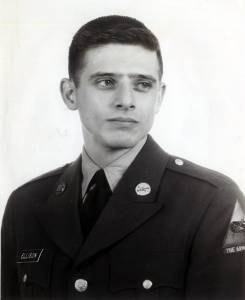
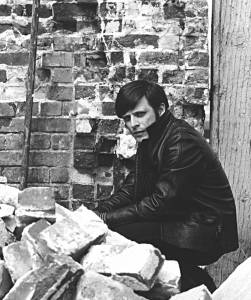
Maybe those writing about him were doing it on assignment and didn’t know Harlan personally. Maybe they only “knew” him through his extremely personal essays or via his often cantankerous, widely gossiped about public antics; or maybe, if they had met him or spent time with him or been on the receiving end of his explosions…their past experiences may have affected their views. Which is understandable if that’s the case: it wasn’t a secret that Harlan carried grudges so why not others? We’re all only human after all.
And Harlan, regardless of his larger-than-life persona, regardless of the views of the insulted or aggrieved, was indeed human, with the failings and virtues and feelings that all of us have. He could, most certainly, be thoughtless and insulting, but he could also, most definitely, be thoughtful, selfless, and compassionate.
He was my friend of 44 years and I loved him. Harlan once told me that one of the hardest things about getting older was having to bury your pals. Of course, he was right.
So I’ve been thinking about him for the last couple of weeks and wanted to take a few moments to share some of my anecdotes, opinions, and observations. They’re not intended as justifications—and certainly not apologies—for anything he may have done to anyone he may have offended in his life: Harlan would have been apoplectic at the notion. Besides, the people who didn’t like him—or with whom he fought—won’t change their opinions and won’t care about anything I might say. That’s perfectly fine. These are simply random thoughts and remembrances by a friend about a friend.
- From the 1930s through the 1950s, fantasy and science fiction were either straight-forward pulp-influenced adventures or staid extrapolations about the future (based on then-current theory and technology); my view has always been that the field evolved and developed a conscience thanks to two people, The Twilight Zone’s Rod Serling and Harlan. Both Serling and Ellison were politically active and socially aware and treated genre conventions with more of an artistic and literary approach. They used their f&sf stories as avenues to comment on bigotry, civil rights, and the human condition—and they succeeded in delivering their messages while entertaining audiences. I don’t think that it’s much of a coincidence that both men frequently fought with network censors and producers—and it was a fight with CBS over his adaptation of the story “Nackles” by Donald Westlake that resulted in Harlan resigning his Creative Consultant position from the updated Twilight Zone series in 1985. It’s well known that Harlan marched with Martin Luther King Jr. from Selma to Montgomery, but he was also an outspoken opponent to the war in Vietnam, a champion of the First Amendment, a vocal advocate of the Equal Rights Amendment, and avid supporter of workers’ rights and unions—all of which were expressed in one way or another in his fiction, essays, and actions. Other writers quickly followed Ellison’s and Serling’s leads, particularly with the advent of the New Wave in the mid-1960s, but I believe the foundation of contemporary F&SF was laid by the works of these two men.
- With that in mind, it is pretty incontrovertible (to me at least) that Harlan emerged from the introverted mass of genre writers (and fans) for a time—in the 1960s and ’70s and maybe early ’80s—to became the “face” of science fiction and helped grow its audience. He worked pretty tirelessly to promote the field’s possibilities and to garner mainstream respect for the form. Harlan stood up and he spoke out when no one else in the F&SF community did; he kicked open a lot of doors that other writers prospered from walking through. Good looking, personable, opinionated, energetic, and quick-witted, he was a favorite speaker on college campuses and gave buzz-worthy interviews in print, on the radio, and on TV. Ray Bradbury may have had greater name recognition and been more polite and respectable, but Harlan as SF’s Angry Young Man (even though he wrote all manner of stuff, not just science fiction) was infinitely more entertaining. Today Stephen King, Neil Gaiman and George R.R. Martin and several others are the much deserved high-profile media stars for our field, but way back when Harlan pretty much stood alone.
- Harlan supported many, many young writers—with encouragement, with inspiration, with advice, with instruction and critiques, with market tips and introductions, and often by providing them with loans or a place to live rent-free and work for awhile. His generosity did not come with strings or expectations (beyond that the person had to work at their craft) and while his kindness occasionally came back to bite him with one houseguest or another, it didn’t prevent him from going out on a limb for others again and again. He also championed older writers that had fallen on hard times (like Fritz Leiber or R.A. Lafferty) and helped them get back on their feet. Harlan would quietly recommend a person for a job or opportunity and never reveal his behind-the-scenes assistance to the recipient. He taught at several writer’s workshops, but—and I could be wrong—I doubt he was a terribly good teacher (I don’t think he had either the patience or the temperament)—however as a nurturing mentor, as a one-man cheerleading squad, he was exceptional (as is proven by the careers of Ed Bryant and Octavia Butler, among others, whom he had taken under his wing). His outbursts got tongues wagging, but his kindness to others has been largely ignored—which is a shame, because his kindness has had a much more significant and long-lasting impact.
- He supported many, many young (and not so young) artists throughout his life, again with introductions to clients and encouragement, but also directly with jobs and the purchase of originals. Harlan’s house was a rambling Aladdin’s treasure cave filled to the brim with paintings, drawings, comic art, sculptures, and…stuff. God, he had stuff. He grew up a comic strip and comic book fan and found pleasure in all manner of art—and the people that produced it. His collection of Dillon paintings was second only to the Dillons’ own holdings; he would prowl convention art shows and either buy hanging pieces or commission young artists to illustrate one of his stories or covers, then arrange for publication and get the artist paid a second time; he would enthusiastically recite to visitors the details of how he came to own paintings by Mark Chiarello, Charles Bragg, or Thomas Blackshear and why he loved them; and he was such a fan of Will Eisner’s The Spirit comic that he had a room constructed on the front of his house which was designed around the trademark window of Denny Colt’s Wildwood Cemetery lair. It’s no wonder that we had asked him to sit on the original Spectrum Advisory Board: he always brought a passion (as you can imagine) to the Grand Master debates.
- Harlan had a billiards table in the middle of his library (which included a spiral staircase up to his second floor office) and he and his friend, actor Peter Falk, used to hustle “marks” in friendly matches. “On those occasions when things were going bad for us,” Harlan told me once, “Peter would wait until someone was about to make a crucial shot, lean forward at the perfect moment, and drop his glass eye on the table. You can imagine the reaction: we never lost.”
- He really hated Walt Disney—oh boy, did he!—partly because of his treatment of his employees, partly because he was stingy with giving his creators credit, but primarily because Disney had testified before the infamous House Un-American Activities Committee in which he had blamed the 1941 animators strike on communists and named various strikers, without justification, as communist sympathizers. Many of those artists were subsequently blacklisted and couldn’t find work for quite awhile (a number had to leave animation to pursue other careers). The flip-side of the coin, though, was that Harlan’s house was jammed full of Disney film figurines and memorabilia; he even said he identified closely with Jiminy Cricket, for christsakes! Of course I had to ask him about the seeming contradiction when Cathy and I were visiting once. “I can separate the man from the work,” was his reply. Which, let’s face it, is pretty mature, particularly these days. Similarly, his shelves were packed with books by people he may have fought viciously with but whose work he respected.
- Harlan was fiercely loyal to his friends—possibly because he knew he didn’t make it easy to be his friend in the first place. Even when there were falling outs (and there were quite a few), he never, to my knowledge, betrayed any of the trusts they had placed in him, even after one or another had died. He knew virtually all of the important and influential creators in our field extremely well—as well as many actors, directors, and producers, too—and knew about all the skeletons in their closets and where the metaphorical bodies were buried. I tried several times to convince him that an unvarnished book describing his relationships and observations would be invaluable: no luck. He wouldn’t have it: it would have been a betrayal. A lot of history—and a lot of secrets—were interred with Harlan. Which undoubtedly is the way he wanted it.
- He was not hesitant in describing how being mercilessly bullied throughout his childhood had a profound impact on the man he became. Whenever he said or did something particularly outrageous, plenty of people would chalk it down to an out-of-control ego or would question whether he had some undiagnosed condition: “No ‘normal’ person behaved that way; something had to be wrong, right?” And, sure, Harlan talked about seeing doctors about deep depression and anger later in life; friends would suspect that he was bipolar, but gentle suggestions that he might benefit from professional help were angrily rebuffed. But to be fair, even if he was bipolar many of his outbursts—even if they were disproportionate—were responses to purposely insulting, disrespectful or mendacious behavior from others. Being the butt of someone else’s joke was intolerable to him and sure to illicit a reaction. I can’t help but believe that many of those perplexed or outraged would conveniently ignore his history of adolescent traumas that he had talked and written about for years as having life-long effects (especially the death of his father when he was 14). He once wrote, “Each of us moves through life shadowed by childhood memories. We never forget. We are bent and shaped and changed by those ancient fears and hatreds. They are the mortal dreads that in a million small ways block us off or drive us toward our destiny.” When he was picked on in some way or made the butt of a joke, whether by friend or foe (and that happened often as an adult, even at ceremonies meant to honor him), his first reaction was to strike back, regardless of the consequences. At heart, Harlan was always the super smart, small Jewish kid who had to fight tooth and nail to survive, to be taken seriously, to stand out, to be heard: the hard survival lessons painfully and repeatedly learned in childhood became so ingrained that they affected his behavior for the rest of his life, for good and, sometimes, for bad.
Along the same lines, I think that at least partially explains his stubbornness with The Last Dangerous Visions anthology (often described as “the most famous unpublished book in the science fiction field”). Harlan’s various announcements of impending publication, the first dating back to 1973, became the petard that others hoisted him on, but the criticisms—like those leveled by Christopher Priest in his lengthy “The Last Deadloss Visions” essay—made him dig in his heels deeper. The simple truth was that LDV came at a time when his career was pulled in a number of different, often more demanding and lucrative, directions and it was ultimately more work than he had the time to devote to it. He was a perfectionist who wanted it the way he wanted it—and he simply couldn’t pull it off. There were plenty of promising stories, like “Pet” or “Dial 9 To Get Out” or the novelization of “A Boy and His Dog” (Blood’s a Rover) that he had worked on periodically but which ultimately languished as well. None of that’s a failure, of course: life has a way of interfering with even the best laid plans. As years passed, as various projects, health issues, and bouts of periodic writer’s block and depression distracted him or laid him low, writing the story introductions as he had for the first two books—the much-lauded hallmark of the anthologies—became more of a Sisyphusian struggle that he was never able to overcome. Calls from others to officially announce it would never be completed and for Harlan to release the stories to appear wherever the authors or their estates deemed fit (all of which he had paid the writers for, some several times over) would have been an admission of defeat. And Harlan, recalcitrant to the end, refused to give them the satisfaction. It was the schoolyard mentality; though he might take some lumps along the way, he wasn’t going to back down. What will happen now? I know he had instructed his wife Susan to destroy all his notes and unfinished works after his death to avoid their being completed by “some literary grave-robber” so my feeling is that LDV will retain its “most famous unpublished book” status. I could always be wrong.
- When I was going through the wasteful, bitter divorce and custody battle with my ex (who had a particularly unscrupulous, opportunistic attorney who eventually lost their license to practice law: trust me, the Bar does listen to complaints) Harlan wrote the story “Anywhere But Here, With Anybody But You” for me as a show of support. He and I had talked about what had been going on and some of the incidents described in the story—fictionalized and filtered by artistic license—actually mirrored some of my experiences (except for the husband kicking the cat at the end, which was all made-up-Harlan-storytelling, not me; I love cats, but he was a dog guy and hated them).
- He was fascinated with Cathy, for a number of reasons I’m sure, but I think primarily because…she wasn’t impressed by Harlan’s celebrity. Before we got together and I eventually introduced them (at a San Diego Comicon) she really didn’t know who he was; Cathy has always read fantasy and SF, but not short stories or fanzines and she had attended only one convention (the 1976 World Con in Kansas City—ask her about her Mark Hamill story) so at the time she’d never read any of his work or heard any of the fan gossip. She had watched The Starlost series (not knowing who Cordwainer Bird was—Harlan’s pseudonym placed on works he’d disowned, like that Canadian TV series) and had seen the A Boy and His Dog film adaptation without his name registering. Which seemed to tickle him silly and he was always trying to figure her out or get some sort of reaction, either with a joke or story or silly posturing, often using various accents and pretending to be someone else when she answered the phone. It never worked: she always treated Harlan like he was, well, any other friend. He once called when I was in the middle of a job rapidly approaching its deadline and I didn’t want to talk to anyone; Cathy answered the phone, spoke for a few moments, then offered it to me while I vigorously shook my head indicating that I was busy. She shoved the phone into my hand and said, “Oh, it’s just Harlan.” Before I could say “hello” I heard him yelling into the receiver, “WHAT’S SHE MEAN THAT IT’S ‘JUST HARLAN’?!? JUST?!?!?! You tell her I’m coming out there! YOU TELL HER I’M ON THE WAY!” I handed back the phone and said, “It’s for you.” She listened to Harlan fuss for a few seconds then asked, “Is Susan coming with you? Because you can’t come visit unless you bring Susan. And you’re going to have to be nice to the cat.” Then they were off and talking and I went back to work; I never did find out what he wanted that night.
- Though he was extremely generous to friends, Harlan didn’t like to feel indebted to anyone, for anything, and it was difficult for him to accept gifts or acts of kindness. I did a bunch of design work for him just because I wanted to and I tried not to invoice him or cash his checks. Which drove him (you guessed it) bugfuck and it would eventually result in a heated phone call. I finally took to cashing his checks then turned around and bought books or tapes or CDs from Susan with
the money—and then he wouldn’t want to cash my check and the whole back-and-forth would start again. Having labored hard to get everything he had in life, he was overly sensitive to others getting compensated for their labors, especially when they were working for him—but generosity extended to Harlan by others did touch him deeply, even if it was also something of a bitter pill to swallow. He didn’t know how to “pay it back” and had a hard time accepting that “pay back” was neither necessary or wanted. Iain McCaig painted the cover for Harlan Ellison’s Brain Movies Volume One and when Iain dropped it off he gave the original to him for his collection; Harlan told me he had to excuse himself under some pretense and, safely out of sight while Susan and Iain chatted, he sat alone on the steps leading up to his office and, in his words “cried like a baby.”
There are plenty of other stories I could tell or observations I could make—over 40 years’ worth, to be exact—but I’ll stop here and conclude by sharing Harlan’s popular “Pay the Writer” clip (because it applies equally to paying the artists as well) and with this quote from his Hugo Award-winning story and Writers Guild of America Award-winning teleplay “Paladin of the Lost Hour”:
“Like the wind crying endlessly through the universe, Time carries away the names and the deeds of conquerors and commoners alike. And all that we are, all that remains, is in the memories of those who cared we came this way for a brief moment.”
I cared, Harlan, and I’ll remember and miss you till I draw my final breath. Rest in peace, my friend.
[Images from top to bottom: (1) Bill Sienkiewicz’s memorial portrait of Harlan, (2) Harlan in the Army, Ft. Benning, GA, 1958, (3) Harlan circa 1968, (4) Leo & Diane Dillon’s cover painting for Strange Wine, (5) Will Eisner’s The Spirit strip featuring the angled circular window Harlan replicated in his home, (6) Walt Disney testifying before the House Un-American Activities Committee, (7) Iain McCaig’s cover painting for Harlan Ellison’s Brain Movies, (8) the Dillons’ cover painting for the album Harlan! Harlan Ellison Reads Harlan Ellison, (9) the “bugfuck button” we had made to promote the book of the same title devoted to Harlan’s quotes that I had edited.



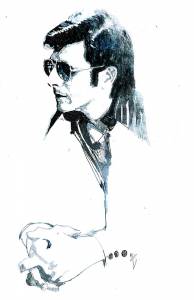
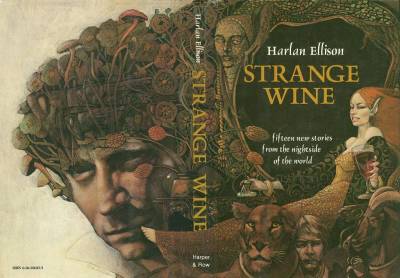
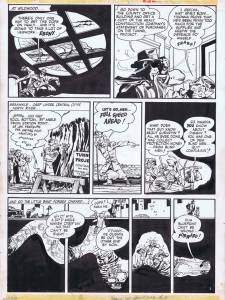
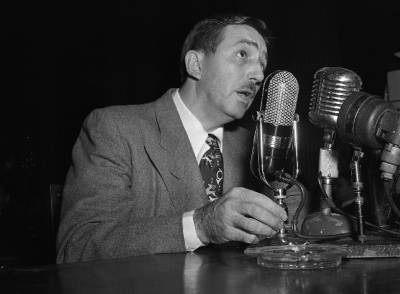
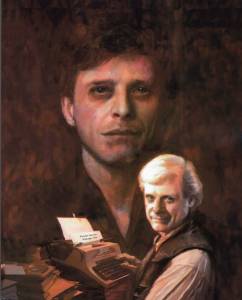
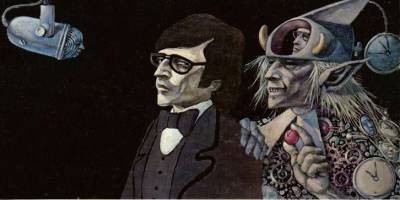
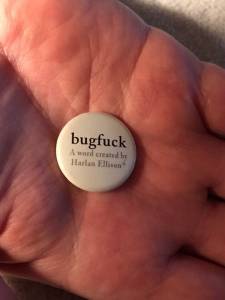
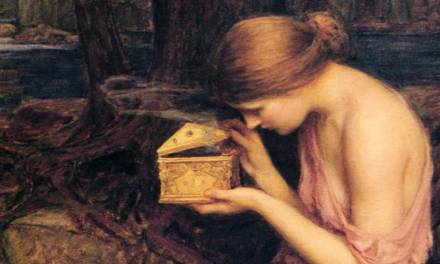
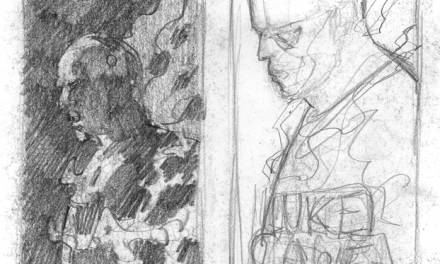
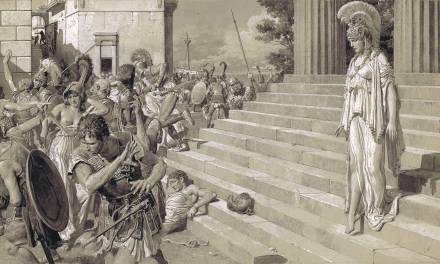
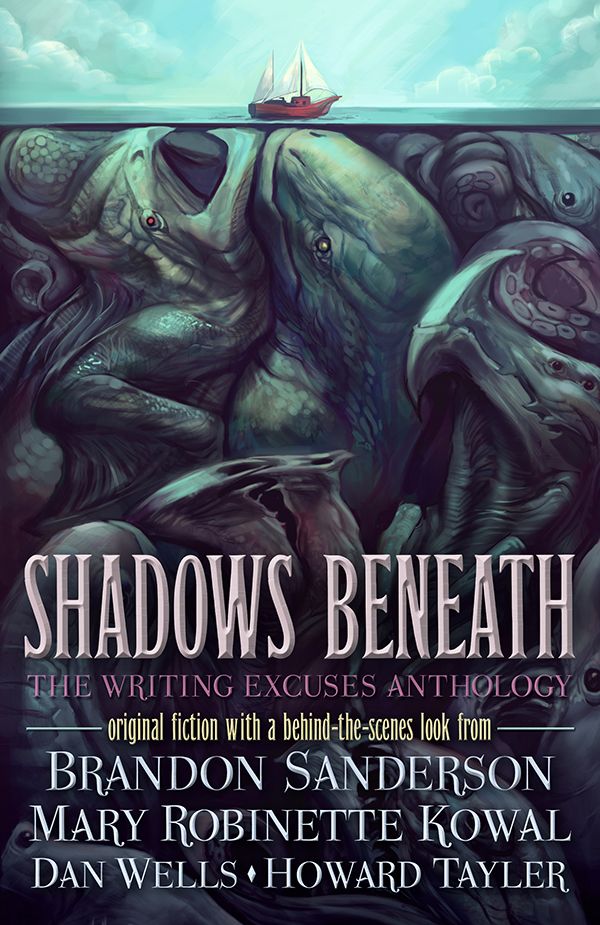
Thank you so much for sharing all these wonderful thoughts and memories
Glad to.
It seems I’ve been missing out on Mr. Ellison’s works, but I’ll aim to fix that. His rapid-fire delivery in that clip is hilarious and his comments are spot-on. Thank you for sharing these stories and candid moments.
“The Essential Ellison” is pretty comprehensive and “The Top of the Volcano” features his most popular award-winning stories. If you can find it, the documentary about Harlan, “Dreams With Sharp Teeth,” is enjoyable; his friend Robin Williams made a couple of funny observations.
Thank you for the recommendations! I shall definitely pick them up.
I met him a few times, as a Los Angeles Science fiction fan. I admit I wasn’t impressed with his public persona, but I agreed with some of his sentiments. I used to listen to Mike Hodel’s Hour 25 on KPFK, and Harlan was a fairly frequent guest. It was a pleasure to listen to those shows because he forgot the mike and just had a conversation with a friend he respected – and the audience got to eavesdrop. One evening he had just come back from Australia, and this was long enough ago that tourists could walk on Ayers Rock. He was so thrilled by the experience, just blown away by the wonder and the beauty of the harsh land, wanting to stay and of course knowing he didn’t have the skills necessary to do so. Thank you for your post, it’s a good one and a good assessment of the man, I think.
Thanks, Elena. Yes, Harlan was close friends with Mike Hodel and, if I remember correctly, after Mike died they tried to keep Hour 25 going with Harlan as an interim host, but it didn’t go on much longer.
The public came to expect the Harlan-As-Provocateur persona and it almost became a schtick that he could and would fall into easily, but there were a lot of sides to him. He and I argued all the time, but always with mutual respect and it never hurt our relationship one iota. I honestly think the vast majority of his well-known battles were because the people he was fighting with treated him with disrespect and didn’t listen: it was all wine & roses when they wanted what he could do, but the second he agreed the romance was over and he was their employee who was expected to ask “How high?” when told to jump. Of course that wasn’t Harlan.
Beautiful post Arn. We’ll all miss him. Thanks for this well thought-out and heartfelt tribute.
Thanks, John. You have YOUR story about meeting him for the first time, too. 🙂
He asked Cathy and I to come to St. Louis to see him in 2015 at Archon: he had mistaken the invitation to be a guest for another convention closer to home, but once he had agreed, that was that, he was going. His body was broken at that point and he was very frail, but he was as sharp as ever and he sat and signed autographs for hours non-stop each day. At one point I plopped down next to him and said, “Harlan, take a break: you don’t need to be doing this.” His reply was, “That’s why I’m here, Toots: to give ’em something to sell on eBay when I’m dead.”
Thank you, Arnie. I don’t know what happened, but I wish we’d spoken.
Oh, Harlan had a jillion friends; there was no way to talk to everyone. Besides, I think you got the balance just right: congratulations on a wonderful job with the biography! (Of course I had to tease Harlan just a little about NESFA being the publisher since he had once gotten into a donnybrook with them some years earlier over the Cordwainer Smith LDV story.)
For those who haven’t read it yet, I encourage to pick up Nat’s book, “A Lit Fuse: The Provocative Life of Harlan Ellison” pronto!
https://www.amazon.com/Lit-Fuse-Provocative-Harlan-Ellison/dp/1610373235/ref=sr_1_1?ie=UTF8&qid=1532541758&sr=8-1&keywords=a+lit+fuse+the+provocative+life+of+harlan+ellison
Captivating glimpse into Harlan’s vivid, dark world.